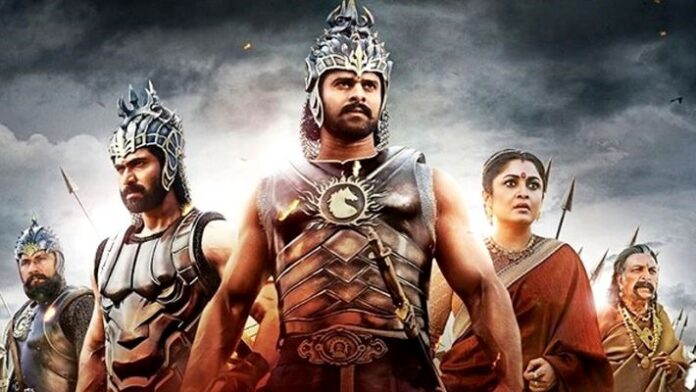The most famous movie that I will talk about in this essay is Baahubali (Part 1 and 2). It is the highest-grossing film of the years 2015 as well as in 2017. This duology has created a history in the world by becoming the first Indian movie that has collected the highest amount of money worldwide. The duology took five years to complete and was directed by SS Rajmouli. The duology cast included Prabhas in the central role supported by Anushka Shetty, Rana Daggupati, Tamannah Bhatia, Ramya Krishna, Satyaraj, and Nassar. It was the first-ever Indian movie that had earned a whopping amount of 500 crores each. There are many reasons why this movie made history in the whole world and took Indian cinema to the next level.
Subject Matter– The duology was a product of the cinema in Southern India. None of the actors who were a part of the movie belonged to the Hindi Film industry. There was not much expectation from South Indian cinema to produce such a great legend in its cinematic effects and the storyline. The life-size characters of Baahubali and Bhallaldev reminded us of the concepts of goodness and evil that always walk side by side in every individual. Sin makes too much noise, while the goodness forever remains calm and composed. As a result, sometimes, people ignore the good aspects of their personalities. Baahubali, getting killed through a conspiracy at the hands of Bhallaldev, reinforces the idea that evil always needs to adopt a wrong path to get victory over goodness. Evil cannot walk with confidence because it knows it is wrong while goodness has nothing to hide. It shows what it is irrespective of what others think about him. In the end, Bhallaldeva was killed by Baahubali’s son, thereby reinstating the concept of victory of good over evil, which we also find in Ramayana.
Personality traits– Every character in the movie represents an idea. Let’s take the example of the main character, Baahubali. He represents what a person should strive to become- an ideal son, an ideal husband, an ideal brother, an ideal ruler, an outstanding and humble king, and of course, an ideal father. Some people will not agree with the above-stated idea, but having a difference in opinions with other people does not restrict one from becoming an ideal person. One can still be an inspiration for others even if one differs in his views from the rest of society and the whole world. Devsena represents a wife’s wrath when her husband and her son are made to suffer without any fault of theirs. Katappa represents the idea that a body can be enslaved but not the mind. He was the slave of the kingdom of Mahishmati, which was ruled by an evil leader, but in his heart, Katappa could distinguish between moral and immoral. Sivgami (Baahubali’s aunt who brought him up like her own child) represents an ideal mother and a humble human being who does not feel ashamed of seeking forgiveness from her daughter-in-law when the former realized her son’s hand in provoking her to get Baahubali killed. She did not hesitate to rectify her mistake by announcing Baahubali’s new-born son to be the next king of Mahishmati Kingdom. When she realized that Baahubali’s new-born son’s life is in danger, she spent not an extra single minute and fled away with him, resulting in saving the child’s life. Bijjaldev (Baahubali’s uncle or his father’s elder brother) represents that a man is considered paralyzed not when he is physically disabled but also when he lacks the distinction between good and evil, moral and immoral. Due to this flawed character, he had developed a feeling of hatred against his younger brother, who was the father of Baahubali. He didn’t stop there; instead, he transferred that feeling of hatred in his son against Baahubali. Last but not least, who can forget Bhallaldev, who is a symbol of greed, jealousy, lust, anger, violence; in short, all the seven cardinal sins? Bhallaldev appeared to be very good and calm on the outer side, but inwardly he was a serpent getting poisoned by his ill feelings.
Direction-Despite such a great theme, if a movie lacks the essential qualities that make it a terrific film, such a movie lasts not more than two days. Therefore, the director gets the maximum credit for every ounce of success. He has to see how different elements go well together to make it a superb piece of entertainment. Music, cinematography, special effects, acting, screenplay, dialogues, action, etc., need to be taken care of by one person. Together, they form a piece that is accepted or rejected by the public. But the movie discussed in this piece of writing was highly accepted and appreciated by the public, so much so that both the parts have been re-released in the first week of November of 2020, i.e., after a gap of 5 and 3 years respectively.
A good ruler v/s a poor ruler- The most significant idea with which people of the whole world could relate themselves was this one. This movie’s success forces us to think about the nature of India’s elected governments and in other parts of the world.
‘What makes one a good ruler?’ is the biggest question which this movie asks us. Is he the one who is loved by the people of his kingdom? Is he the one who does not practice archaic traditions like an animal sacrifice before commencing a big task? Is he the one who refuses to follow the age-old customs and traditions in the interest of the people of his kingdom? Is he the one who puts up a strong fight not only against the enemies of his country but also of his states as Baahubali did for the Kuntal kingdom? Is he the one who risks his life but never sided with the evildoers….? And if yes, such a person deserves to become the country’s ruler, why is Bhallaldev ruling the kingdom of Mahishmathi? So is it due to this very reason that this movie became a blockbuster hit in the whole world and not only in India? The cause is not known despite the varied possibilities. Have people from different parts of the world answered that question by making this movie a blockbuster hit? Does every time a Baahubali gets killed by a Bhallaldev? Do the future generations reap the fruits of the plants of hatred that their fathers have sown? And the biggest question – if the destiny of Mahishmati Kingdom could be changed after 26 years, can this happen in other cases? If evil forces rule a nation for a long time, does that blur the possibility of change?
This movie has been successful enough in attacking the hearts of people and their minds. It has evoked many questions like those mentioned above and has left it upon the viewers and critics to find their answers. This movie is not just a story presenting characters, but it is an amalgamation of such great thoughts and concepts that its few drawbacks could easily be overlooked. Although the movie’s story has ended after the second part, the story of a government and a country never ends. It keeps evolving and growing, and every country needs a BAAHUBALI to protect its glory, respect, honour, and prestige against every BHALLALDEV that obstructs its way.
Rushika Gill, Amritsar
















